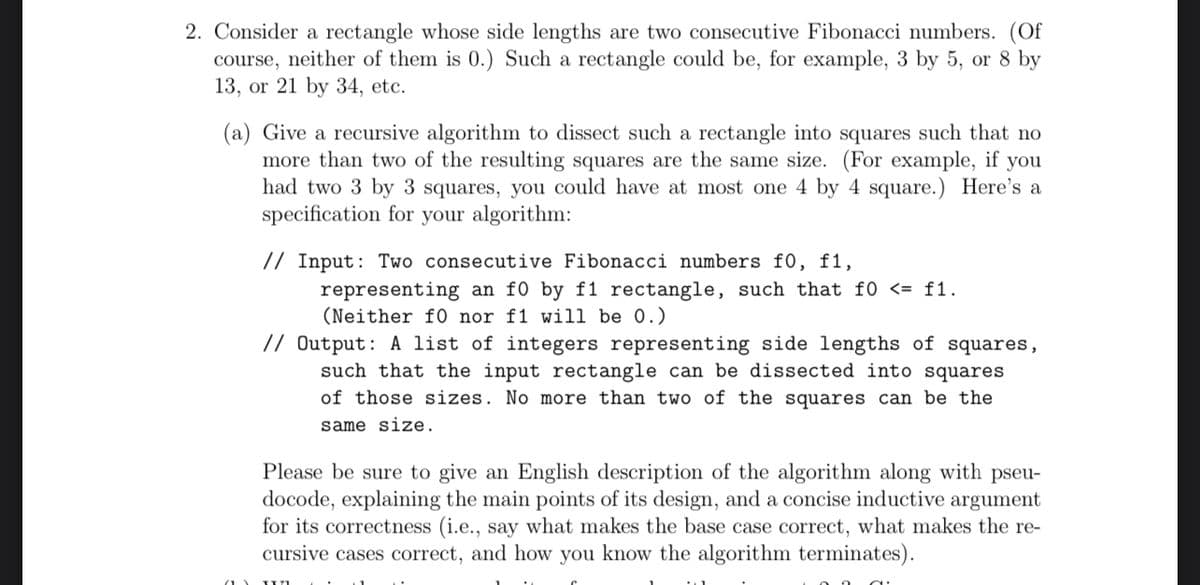Consider a rectangle whose side lengths are two consecutive Fibonacci numbers. (Of course, neither of them is 0.) Such a rectangle could be, for example, 3 by 5, or 8 by 13, or 21 by 34, etc. (a) Give a recursive algorithm to dissect such a rectangle into squares such that no more than two of the resulting squares are the same size. (For example, if you had two 3 by 3 squares, you could have at most one 4 by 4 square.) Here's a specification for your algorithm: // Input: Two consecutive Fibonacci numbers f0, f1, representing an f0 by f1 rectangle, such that f0 <= f1. (Neither f0 nor f1 will be 0.) // Output: A list of integers representing side lengths of squares, such that the input rectangle can be dissected into squares of those sizes. No more than two of the squares can be the same size.
Consider a rectangle whose side lengths are two consecutive Fibonacci numbers. (Of course, neither of them is 0.) Such a rectangle could be, for example, 3 by 5, or 8 by 13, or 21 by 34, etc. (a) Give a recursive algorithm to dissect such a rectangle into squares such that no more than two of the resulting squares are the same size. (For example, if you had two 3 by 3 squares, you could have at most one 4 by 4 square.) Here's a specification for your algorithm: // Input: Two consecutive Fibonacci numbers f0, f1, representing an f0 by f1 rectangle, such that f0 <= f1. (Neither f0 nor f1 will be 0.) // Output: A list of integers representing side lengths of squares, such that the input rectangle can be dissected into squares of those sizes. No more than two of the squares can be the same size.
Computer Networking: A Top-Down Approach (7th Edition)
7th Edition
ISBN:9780133594140
Author:James Kurose, Keith Ross
Publisher:James Kurose, Keith Ross
Chapter1: Computer Networks And The Internet
Section: Chapter Questions
Problem R1RQ: What is the difference between a host and an end system? List several different types of end...
Related questions
Question

Transcribed Image Text:2. Consider a rectangle whose side lengths are two consecutive Fibonacci numbers. (Of
course, neither of them is 0.) Such a rectangle could be, for example, 3 by 5, or 8 by
13, or 21 by 34, etc.
(a) Give a recursive algorithm to dissect such a rectangle into squares such that no
more than two of the resulting squares are the same size. (For example, if you
had two 3 by 3 squares, you could have at most one 4 by 4 square.) Here's a
specification for your algorithm:
// Input: Two consecutive Fibonacci numbers f0, f1,
representing an f0 by f1 rectangle, such that f0 <= f1.
(Neither f0 nor f1 will be 0.)
// Output: A list of integers representing side lengths of squares,
such that the input rectangle can be dissected into squares
of those sizes. No more than two of the squares can be the
same size.
Please be sure to give an English description of the algorithm along with pseu-
docode, explaining the main points of its design, and a concise inductive argument
for its correctness (i.e., say what makes the base case correct, what makes the re-
cursive cases correct, and how you know the algorithm terminates).
T
Expert Solution
This question has been solved!
Explore an expertly crafted, step-by-step solution for a thorough understanding of key concepts.
This is a popular solution!
Trending now
This is a popular solution!
Step by step
Solved in 4 steps

Recommended textbooks for you

Computer Networking: A Top-Down Approach (7th Edi…
Computer Engineering
ISBN:
9780133594140
Author:
James Kurose, Keith Ross
Publisher:
PEARSON

Computer Organization and Design MIPS Edition, Fi…
Computer Engineering
ISBN:
9780124077263
Author:
David A. Patterson, John L. Hennessy
Publisher:
Elsevier Science

Network+ Guide to Networks (MindTap Course List)
Computer Engineering
ISBN:
9781337569330
Author:
Jill West, Tamara Dean, Jean Andrews
Publisher:
Cengage Learning

Computer Networking: A Top-Down Approach (7th Edi…
Computer Engineering
ISBN:
9780133594140
Author:
James Kurose, Keith Ross
Publisher:
PEARSON

Computer Organization and Design MIPS Edition, Fi…
Computer Engineering
ISBN:
9780124077263
Author:
David A. Patterson, John L. Hennessy
Publisher:
Elsevier Science

Network+ Guide to Networks (MindTap Course List)
Computer Engineering
ISBN:
9781337569330
Author:
Jill West, Tamara Dean, Jean Andrews
Publisher:
Cengage Learning

Concepts of Database Management
Computer Engineering
ISBN:
9781337093422
Author:
Joy L. Starks, Philip J. Pratt, Mary Z. Last
Publisher:
Cengage Learning

Prelude to Programming
Computer Engineering
ISBN:
9780133750423
Author:
VENIT, Stewart
Publisher:
Pearson Education

Sc Business Data Communications and Networking, T…
Computer Engineering
ISBN:
9781119368830
Author:
FITZGERALD
Publisher:
WILEY